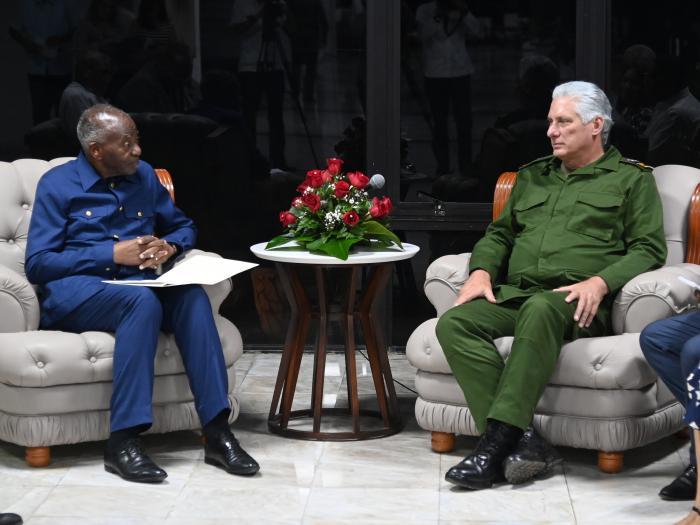

Maintaining the beauty of the city is everyone's responsibility Photo: José Manuel Correa
The First Secretary of the Central Committee and President of the Republic, Miguel Díaz-Canel Bermúdez, learned about the investments being made in Havana's central sewage system, which will significantly improve the evacuation of sewage water from five municipalities, during his usual Saturday tours around the city, which served to celebrate the city's 505th birthday.The Head of State's journey advanced in the Havana Siphon Grating Chamber, also known as the Cavalry Cube, a futuristic construction that masks the devices dedicated to stop and extract solid waste of certain granimetry, to lessen the obstruction of the sewage flow of the centenary conduit, described as one of the wonders of Cuban engineering.A donation of nearly one million Euros from Spanish institutions, plus millionaire funds from the country in local currency, contribute to rehabilitate a vital service which, due to the lack of resources for its maintenance, was very limited.The works include the acquisition and installation of floodgates, valves and the repair of the automatic cleaning system of the Cámara de Rejas and motors for the Casa Blanca pumping station that drive the discharges, through a submarine outfall, to the depths of the Gulf of Mexico.The investments will have a major impact on the municipalities of Old Havana and Central Havana, especially in low-lying areas where, due to obstructions in the system, a critical situation is being faced today, with sewage spilling into buildings and streets.In the tour of Old Havana, Plaza and Cerro, aimed at verifying the recovery after the passage of Hurricane Rafael, the President was accompanied by the member of the Political Bureau, Roberto Morales Ojeda, Secretary of Organization of the Central Committee of the Party; José Ramón Monteagudo Ruiz, member of the Secretariat of the Central Committee, and Inés María Chapman Waugh, Deputy Prime Minister.Also in attendance were Liván Izquierdo Alonso, first secretary of the Provincial Committee of the Party; Yanet Hernández Pérez, governor of Havana, and the political and governmental authorities of each of the municipalities visited.Díaz-Canel, as he does every day in these tours, verified the behavior of solid waste collection in the capital, emphasizing the discipline and technological organization required, and in which it is indispensable that the workers of Comunales(state trash collectors) leave the places arranged for the containers very clean, which, he demanded, must be left in place and covered.He inquired about the water supply to the city and the state of the pumps in the water supply sources, which are gradually recovering, although some of them have been broken. The president of the National Institute of Hydraulic Resources (INRH), Antonio Rodríguez Rodríguez, informed that at this moment some 250,000 habaneros are without service."We are still in a worse situation than before the cyclone," Diaz-Canel told the authorities of the INRH and the capital, who explained that the work being carried out in the springs will reduce the damage in the short term.BEAUTIFUL PROJECTS, DESPITE LIMITATIONSAccompanied by Perla Rosales Aguirreurreta, deputy director of the Office of the Historian, the President checked the recovery works of the old Sarrá Palace, which has been restored to almost all its splendor using national materials and with the support of the Saudi Fund for Development.Together with the former Palacio de las Cariátides, which houses the Hispano-American Center of Culture, the Sarrá is the building with the greatest heritage value in the traditional Malecón; it is considered "a singular piece of the first decades of the 20th century in Havana."The building will now house the Nodo Habana project, described as "a space for dialogue between the arts and design, a venue for various cultural and academic events, with a leading role for micro-theater and music."The beautiful palace will be managed by the local development project Sinfiltro, and will host the next Architecture Biennial.Received by artists and architects involved in the recovery and management of the center, among them the first vice-president of Uneac, Magda Resik Aguirre, Diaz-Canel observed different areas of the building and noted once again, as he said, how, despite the difficult times, it is possible to undertake large and beautiful projects like this one.WITH HAVANA'S INHABITANTS BROOM IN HANDIn the 84th district of the popular council Vedado Malecón, municipality of Plaza de la Revolución, Díaz-Canel shared with youth and student brigades, and workers of state institutions that participated in the sanitation of the city.Vedado is already an area recovered from the hurricane damage, and now the task is to make the cleaning sustainable with the specialized work of Comunales and the support of the neighbors, said the President, who practically greeted, one by one, about a hundred people who, broom in hand, were striving to make this a cleaner city, although the task is ambitious.Under the leafy trees that characterize Vedado, the Head of State learned about the program for the pruning and treatment of these, some of them almost centenarians that, although their shade is blessed in the days of heat wave, constitute a real danger to power lines in case of hydrometeorological situations, in addition to lifting the sidewalks and flowerbeds that stand in the way of their roots.He praised the sanitation work being carried out in Vedado by volunteer forces and called for the incorporation of the inhabitants of the neighborhood, "what better than having the neighbors participating in the cleaning and beautification," he stressed.We will not be able to maintain the number of teams that are working today in the cleaning of Havana, said the president, but it will help a lot, he said, if every week, led by the CDRs and the work centers established in the area, people go out to clean the streets and take care of the gardens and flowerbeds of their blocks.The same experience could be seen in the municipality of El Cerro, where workers and neighbors of the territory cleaned the surroundings of the Sports City traffic circle.Talking to an enthusiastic group of cederistas and workers from labor centers who were doing the work, Díaz-Canel told them that what they were doing showed "that it can be done". This city is beautiful," he said, "but we have to start healing its wounds."
Photo: Estudios Revolución
Photo: X account of Presidencia Cuba
Photo: Estudios Revolución
Photo: Estudios Revolución
Photo: Estudios Revolución
Photo: Estudios Revolución
Related News

A dialogue that supports the friendship between Namibia and Cuba

Mexico and the United Nations offer support to Cuba for its recovery

There are investments that are being worked on for the future of the country


